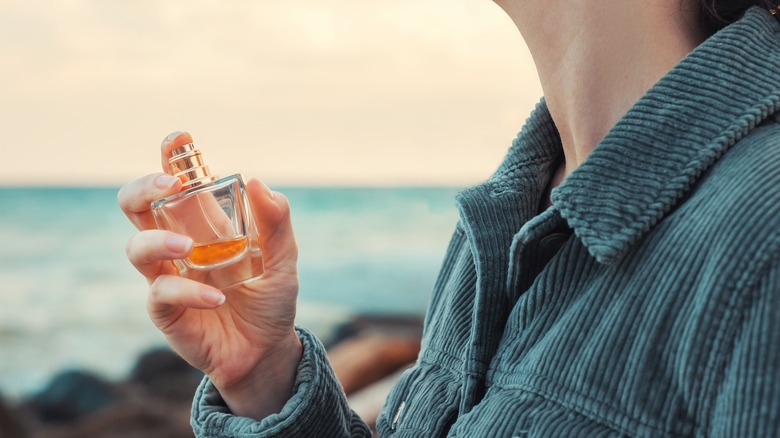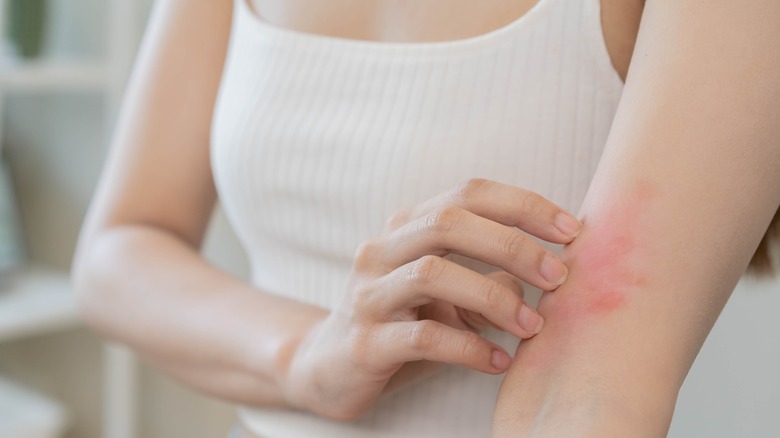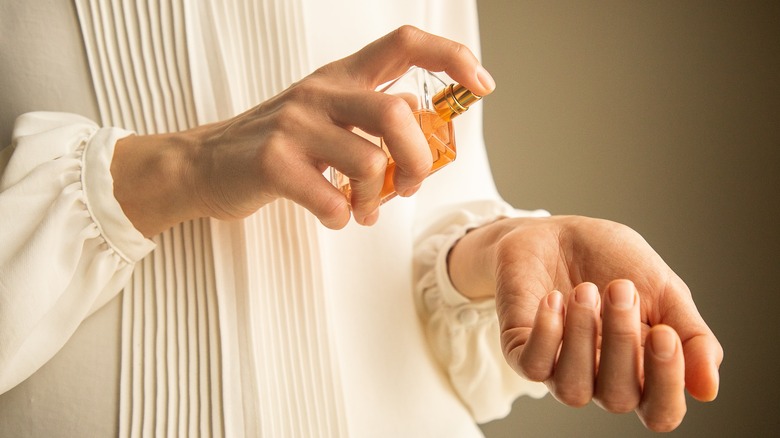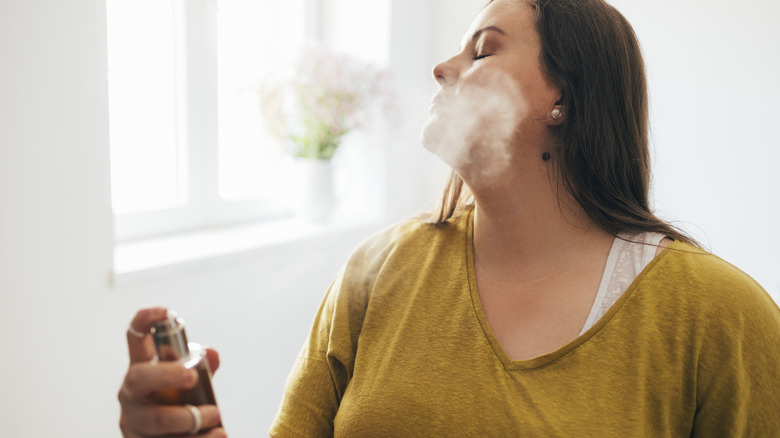Should You Avoid Wearing Perfume In The Sun? A Perfumer Explains The Risks
Sunscreen is a must when you're in the sun, but is wearing perfume a no-go? Avoiding perfume when you're in the sun likely isn't something that jumps to the front of your mind when you get ready to head outside, but the ingredients and chemical compositions in many fragrances can interact differently when exposed to sunlight, resulting in uncomfortable reactions to your skin.
Kalliope Amorphous, a professional perfumer and founder of the perfume house Black Baccara, tells Glam exclusively that some perfumes can lead to skin sensitivities when exposed to sunlight. So, while you don't necessarily have to avoid all perfumes and body sprays when spending time outdoors or in rooms with significant natural light exposure, there are some key components to know before you spritz on your favorite scent for fun in the sun.
During the manufacturing process of modern perfumes, a variety of ingredients are used to create the sweet, sultry, and spice-centric scents available on the market today. Combinations used in bottled fragrances can be cocktails of natural components or synthetic materials. Typically, naturally derived elements from fruit and floral sources, plants, and certain types of strong-smelling wood are used alongside synthetic compounds for the preservation of the solution and longevity of the liquid's fragrance, though sometimes synthetic simulations of natural scents are used when natural derivatives aren't available. Some fragrances use petrochemicals, coal, tar, animal musks, and skin-irritating alcohol. Whether natural or synthetic, certain ingredients can lead to adverse skin reactions when worn outdoors.
The science of sunlight and scented sprays
Something you probably didn't learn in high school biology and chemistry is how cosmetics react with both your skin and external elements (which would have been helpful to know). Some basic scientific elements can help you discern the integrity and safety of specific scented sprays when in the sun, especially when determining if you're experiencing a sunburn or a skin reaction to light exposure reacting with your perfume's ingredients. "Some perfumes can cause a phototoxic reaction when exposed to the sun. Fragrances containing natural citrus ingredients like lemon, orange, grapefruit, or others from the citrus family may cause a phototoxic reaction in those with sensitive skin and it usually shows up as a rash similar to sunburn," Kalliope Amorphous exclusively tells Glam. The same can be said for citrus essential oils — one common mistake people make when using essential oils.
The reactivity of citrus to sunlight is frequently used in hair lightening products, including DIY hair lightening using lemon juice and sunlight exposure to bleach strands of hair. If citrus compounds can change the color of your locks, it makes sense that the same scientific principles apply to components of citrus in body sprays. The increased sensitivity resulting from sunlight's reaction with citrus elements on the body can lead to hyperpigmentation, changes in skin appearance, and contact dermatitis symptoms including rashes, redness, and irritation, as Amorphous emphasizes. If you notice signs of a reaction, immediately use soap and water to cleanse your skin.
Some sunlight skin reactions take days to surface
While some perfumes interact with sunlight almost immediately, leading to instant signs of skin sensitivity, other fragrances may produce stealthier skin sensitivity when worn out in the sun. Kalliope Amorphous exclusively explains to Glam, "Some fragrances can also cause a photoallergic reaction in certain people. A photoallergic reaction doesn't show up until a few days after sun exposure."
Symptoms of phototoxic reactions appear as quickly as within mere minutes of sunlight exposure to skin sprayed with perfume, but photoallergic reactions provoke more extensive immune system responses, leading to delayed symptoms. When a photoallergic reaction occurs, the chemical reaction created when sunlight stimulates the ingredients in a fragrance or perfume alerts your body's immune system to a safety threat and attacks the affected area of skin accordingly. Since it can take your body a few days to build up its attack forces of antibodies, photoallergic reactions generally don't become noticeable for approximately 24 to 72 hours after the initial exposure to sunlight, which can make identifying the culprit of your skin's adverse reaction tricky if you aren't aware of how sunlight and perfumes can interact.
Side effects of photoallergic reactions tend to be painful and include itchy patches of skin accompanied by rashes or clusters of bumps, cracked or peeling skin, and the formation of blisters or pustules of varying sizes that can become extremely tender, often oozing or becoming inflamed or swollen.
Experts recommend patch testing your perfume
Though advancements in safety measures in the creation of cosmetics have been made, everyone's skin is different and reacts uniquely to components. "Most responsible perfumers follow IFRA safety limits on materials like citrus and other materials likely to cause allergies, but that doesn't mean someone won't experience an allergic reaction to it, especially when exposed to the sun," Kalliope Amorphous exclusively tells Glam, referencing the best practices set forth by The International Fragrance Association.
To know how your skin uniquely reacts to a specific perfume, Amorphous advises patch testing your skin, which can be conducted by spraying a small amount of a fragrance onto a specific spot of skin and then keeping an eye on it for potential signs of an adverse reaction. Patch testing is a way to preemptively discern potential skin sensitivities to a product in a controlled manner. For instance, you may choose to spray a small amount of a fragrance on the back of your hand or small area of your arm, then note if symptoms of a phototoxic reaction develop within a few hours or if more delayed symptoms from a photoallergic reaction arise after one to three days.
Routine patch testing is a good practice to cultivate with cosmetics. Amorphous explains, "Even if you think your skin isn't sensitive, sensitization can occur over time. In other words, the more often you wear it, the more likely you are to develop an allergy."
Tips for wearing perfume in the sun
When you love the scent of a favorite fragrance, it can be disappointing to be unable to wear it outdoors. Though avoiding skin irritation is likely preferable to slathering on your preferred perfume, there are ways to practice the safety-conscious wearing of scented sprays in the sun. Kalliope Amorphous recommends avoiding direct skin application, saying, "You can always spritz your clothing instead so that you can still enjoy the fragrance without risking a reaction."
If you're uncertain of the ingredients in a given fragrance — some contain harmful chemicals – or simply seek to learn more about the solution in a bottle of perfume, Amorphous exclusively advises us, "When in doubt, you can always ask the perfumer if there are certain ingredients in the blend that are known for not playing well with the sun." Be mindful that amounts of specific ingredients can differ from bottle to bottle and batch to batch.
Since skin safety is imperative, especially when it comes to sun exposure, always err on the side of caution. Amorphous emphasizes avoiding wearing perfume in sunlight, especially if you have sensitive skin — these are signs you may have sensitive skin. "If your skin is known to be sensitive or the fragrance is citrus heavy," she says, "I wouldn't recommend wearing fragrance if you are going to have any sort of prolonged exposure to the sun."




